“We should get a puppy!” is how the conversation often starts, frequently from wide-eyed kids wanting a furry friend. But when choosing a dog, how do you know which breed is best for you? You probably want your dog to be with you as long as possible, but what if you fall in love with a breed that has a reputation of having a shorter lifespan? Getting the facts ahead of time can prepare you for what to expect and to make the most of your time together!
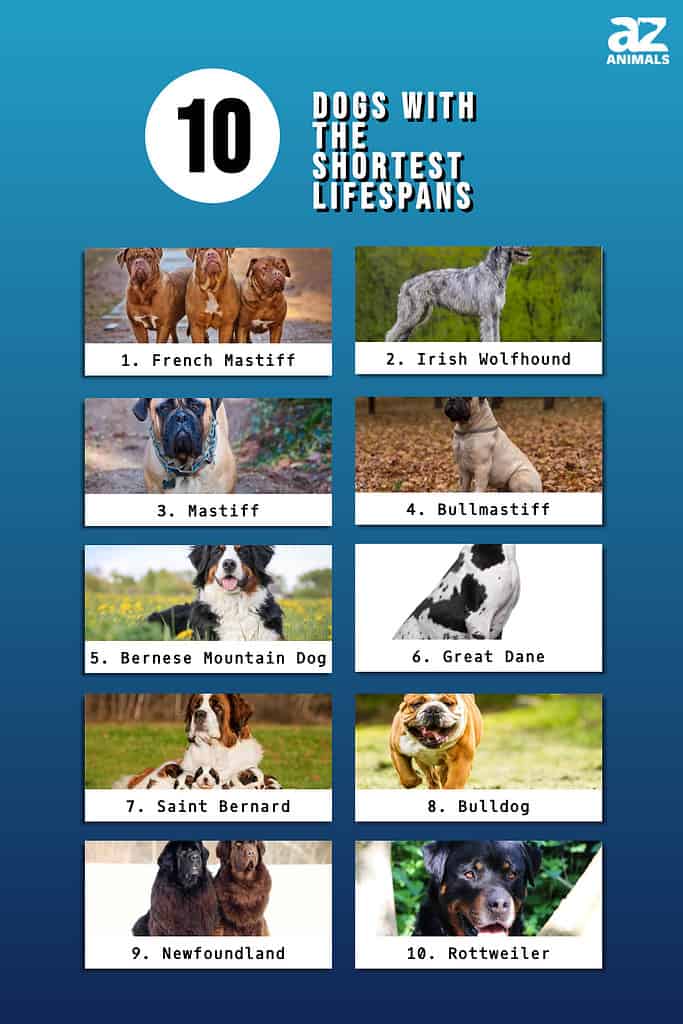
Big Dog vs. Little Dog
In the animal world, big animals typically live longer than smaller animals. The larger animals are usually at the top of the food chain and have fewer predators. When it comes to domestic dogs, it is the opposite, with smaller dogs outliving larger breeds. Researchers are still studying this but believe that the rapid growth that larger dogs experience contributes to them aging faster and developing diseases earlier, leading to a shorter lifespan.
What Health Problems Can Cause a Shorter Life?
Some dog breeds are more susceptible to certain kinds of issues and diseases. Giant breeds like great Danes, Saint Bernards, and mastiffs are prone to bloat, which is a condition where the blood supply to vital organs gets cut off when their stomach gets twisted. Proper feeding techniques like feeding your dog more frequent smaller meals and not having them exercise right before or after a meal can help prevent bloat.
Cancer is the number one killer of dogs for many breeds. Bone cancer is especially common in Irish wolfhounds, rottweilers, and mastiffs. Older dogs are susceptible to a variety of other cancers as well. One thing dog owners can do to reduce the risk that their dog will develop cancer is to help their dog maintain an ideal weight. Having an overweight dog can increase the chances of certain cancers as well as increase the odds of developing diabetes and heart conditions.

Some dog breeds are prone to diseases that shorten their lifespan.
©Javier Brosch/Shutterstock.com
What Can You Do to Help Your Dog Live Longer?
Here are a few tips to help your dog live longer:
- If you are buying your dog from a breeder, be sure to work with one that follows all the proper guidelines for breeding to avoid certain conditions resulting from inbreeding and overbreeding.
- Be sure your dog gets proper veterinary care, including checkups and recommended vaccinations.
- Follow your vet’s recommendations for feeding schedules and types of food. Watch your pet’s weight to be sure they do not become overweight, which can lead to issues.
- Provide proper exercise for your dog’s breed.
- Be aware of specific issues for your dog’s breed and age, and be watchful for signs of trouble so it can be addressed early.
How Long Do Dogs Live?
It obviously depends on the breed, but the average lifespan of dogs ranges between 10 to 13 years in age. They can even live up to about 30 years old! Keeping your pup healthy and at a good weight helps them live longer.
What Breeds Have the Shortest Lifespans?
Let’s take a closer look at each of the breeds with the shortest lifespans to find out what makes them prone to shorter lives.
10. Rottweiler, 9-10 Years

Rotweillers have rust-colored accents on their face and paws.
©iStock.com/BiancaGrueneberg
Rottweilers sometimes have a bad reputation for being aggressive dogs, but just like any breed with proper training and socialization, they are affectionate pets. Rottweilers are one of the smaller dogs on our list but are sturdy dogs, with males weighing 95-135 pounds. They have short dark-colored coats with rust-colored accents on their face and paws. Rottweilers live between nine and ten years and have the following concerns as a breed:
- Bone cancer
- Parvovirus.
9. Newfoundland, 9-10 Years
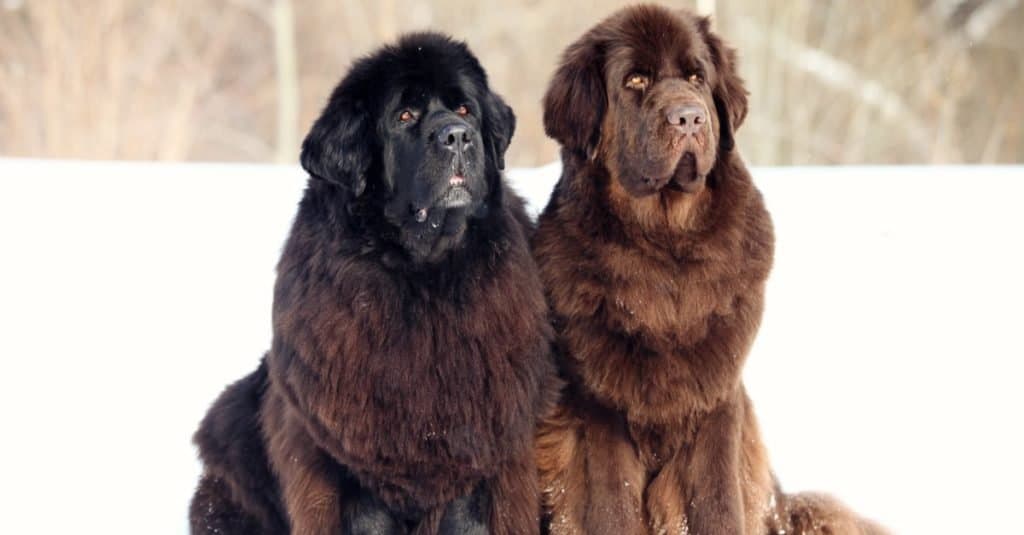
Newfoundlands are often used as water rescue dogs because of their muscular build, thick double coat, and their webbed paws.
©iStock.com/Dixi_
Newfoundlands can get up to 150 pounds and be 28 inches at the shoulder. Despite being so big, they are a gentle breed that is known to be good with kids. The dog Nana in Peter Pan is a Newfoundland! These dogs have flat, coarse fur that comes in a variety of colors; brown, white, black, and black-and-white. They are actually good swimmers, with their paws being partially webbed. Newfoundlands can live to be nine and ten years of age. Some of the most common issues with this breed are:
- Heart failure due to subaortic stenosis
- Bloat
- Heat-related issues
- Sensitive to anesthesia.
8. Bulldogs, 8-10 Years
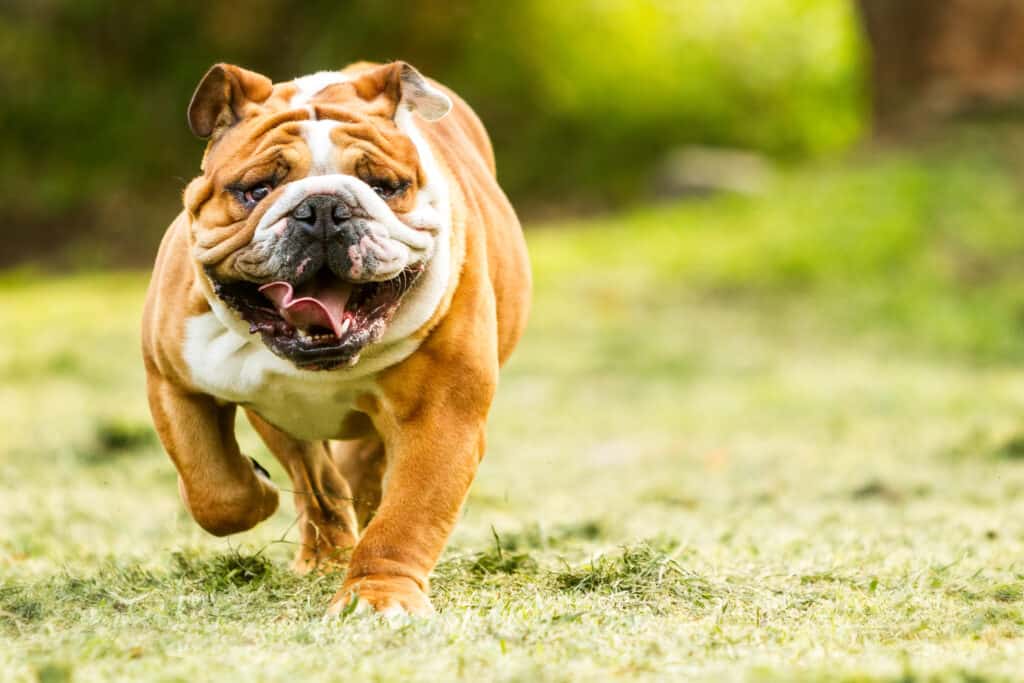
Bulldogs are easy to identify due to their wrinkly faces and bodies, their stocky build, and their shortened muzzles.
©Ammit Jack/Shutterstock.com
Bulldogs aren’t big dogs, but they have more health issues than most breeds, which makes them have shorter lifespans. Bulldogs are characterized by their wrinkly flat faces with saggy cheeks and loose skin. They are short and stocky, with the males weighing close to 50 pounds. Bulldogs come in a variety of colors and patterns. Bulldog owners will argue their dogs have the cutest faces, but not everyone agrees! The bulldog typically lives eight and ten years, with some of the issues to be concerned with being:
- Breathing issues due to being brachycephalic (broad and short-skulled face)
- Compromised immune systems
- Heat-related issues.
7. Saint Bernard, 8-10 Years
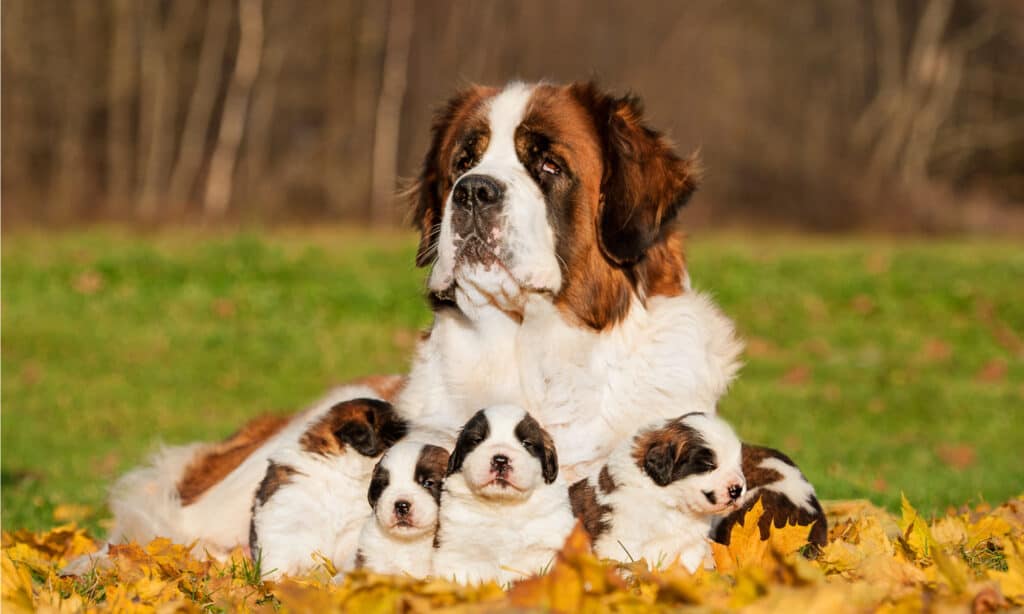
Saint Bernards can grow to 30 inches at the shoulder and reach 180 pounds.
©Rita_Kochmarjova/Shutterstock.com
When I think of big dogs, Saint Bernard is one that comes to mind. These are the rescue dogs of the Alps that have been pictured with a cask around their necks. The rescue part of this story is true, but the cask of brandy is fictional. Saint Bernards are now lovable giant pets and can grow to be 30 inches at the shoulder and weigh 180 pounds. Their coloration is mixed colors with dark brown around their faces, a white snout, a white stomach and paws, and a tan back. Saint Bernards have an average life expectancy of eight to 10 years. Some health issues that are common with Saint Bernards are:
- Heart disease
- Cancer
- Epilepsy
- Bloat.
6. Great Dane, 7-10 Years

Great Danes are among the tallest dogs, reaching an average height of 30 to 32 inches at the shoulder.
©Eric Isselee/Shutterstock.com
Great Danes and Irish wolfhounds are among the tallest dog breeds in the world. The Great Dane’s average height at the shoulder is 30-32 inches, and they weigh around 140-175 pounds. They have very short, coarse fur that comes in a variety of colors and patterns. They have long legs, and it is amazing to watch these giants run. Great Danes have a life expectancy of seven to 10 years, with bloat being a major concern for this breed.
- Bloat.
5. Bernese Mountain Dog, 7-10 Years (Possibly Closer to 6-8)
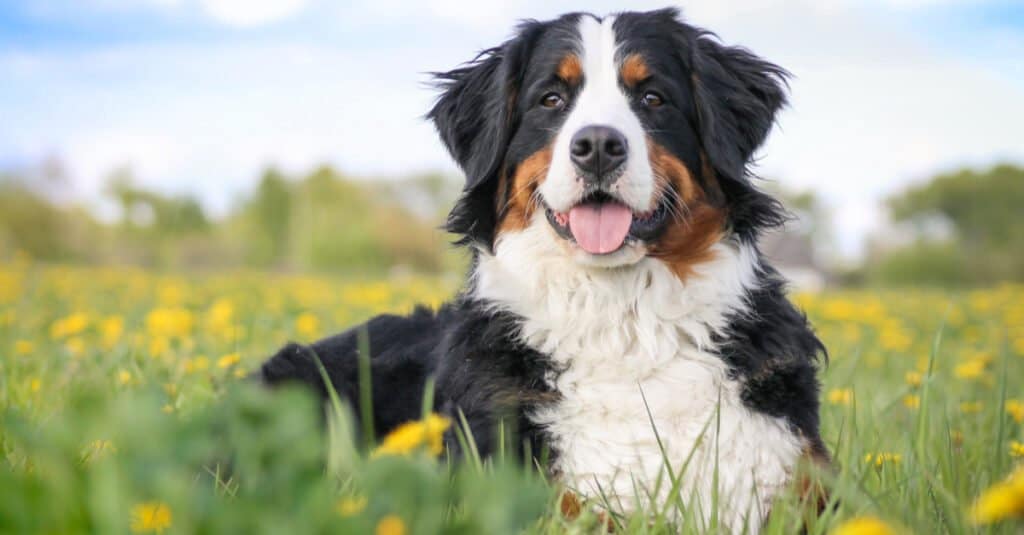
Bernese mountain dogs are tri-colored, with black, white, and rust markings.
©Eve Photography/Shutterstock.com
These large dogs are a furry favorite because of their sweet temperaments. Bernese mountain dogs are around 110 pounds and 27 inches tall with long fur. Their fur is a mix of black backs, white chests and paws, and rust legs and facial markings. Bernese mountain dogs are listed to live seven to10 years, but there are concerns in recent years that this life expectancy is getting shorter due to breeding practices and may be closer to six to eight years. They are also more likely to get cancer than most breeds. Here are the concerns of these giants:
- Cancer
- Bloat
- Heart issues.
4. Bullmastiff, 7-9 Years
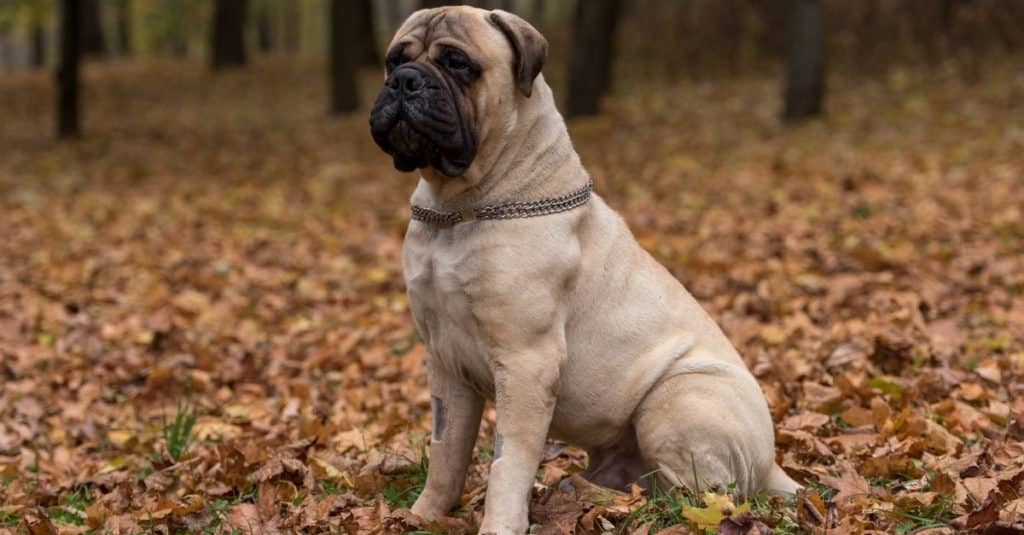
Bullmastiffs are massive dogs that can reach up to 130 pounds.
©photosounds/Shutterstock.com
As the name implies, the bullmastiff is a cross of Bulldogs and Mastiffs. They really do look like the head of the bulldog on a mastiff’s body. They can get to be 130 pounds and are 27 inches tall at the shoulder. Bullmastiffs make great guard dogs because they were bred to ward off poachers in England. They have a life expectancy between that of the bulldog and mastiff at seven to nine years. Common concerns are:
- Bloat
- Heart Disease
- Cancer.
3. Mastiff, 6-10 Years
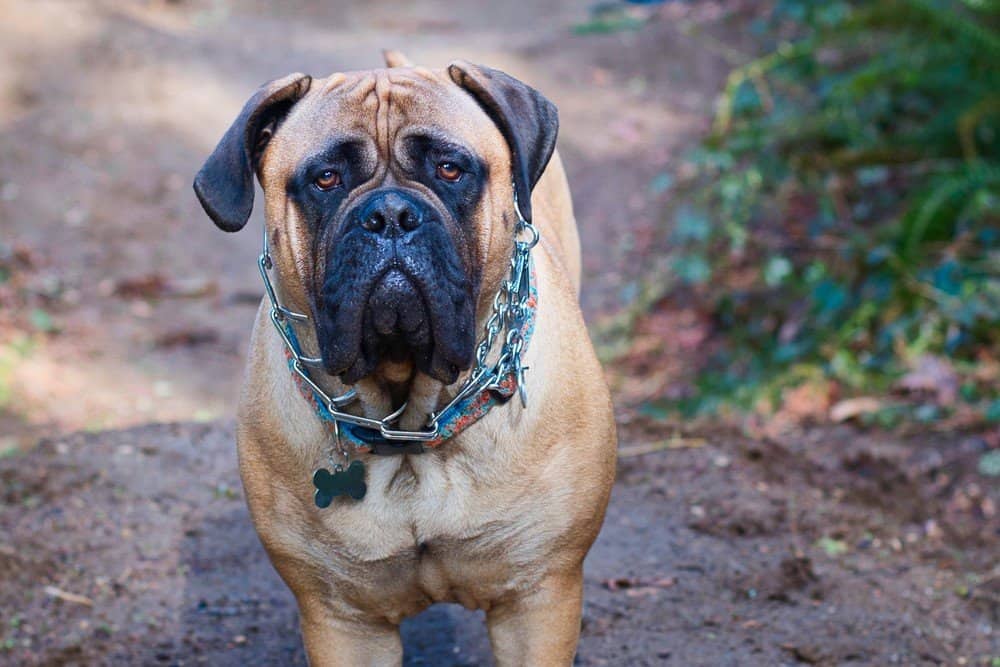
Mastiffs generally have short tan fur with a black muzzle and ears.
©Michael J Magee/Shutterstock.com
Mastiffs are characteristically giant dogs with short tan fur and black faces and ears. Can you believe that mastiffs can grow to 230 pounds? These giant dogs are very affectionate and loyal to their families. They are more prone to bone cancer than other dogs, and breeders are cautious of this when breeding. Mastiffs can live between six to 10 years, with common concerns being:
- Bone Cancer
- Bloat
- Heart Disease.
2. Irish Wolfhound, 6-8 Years
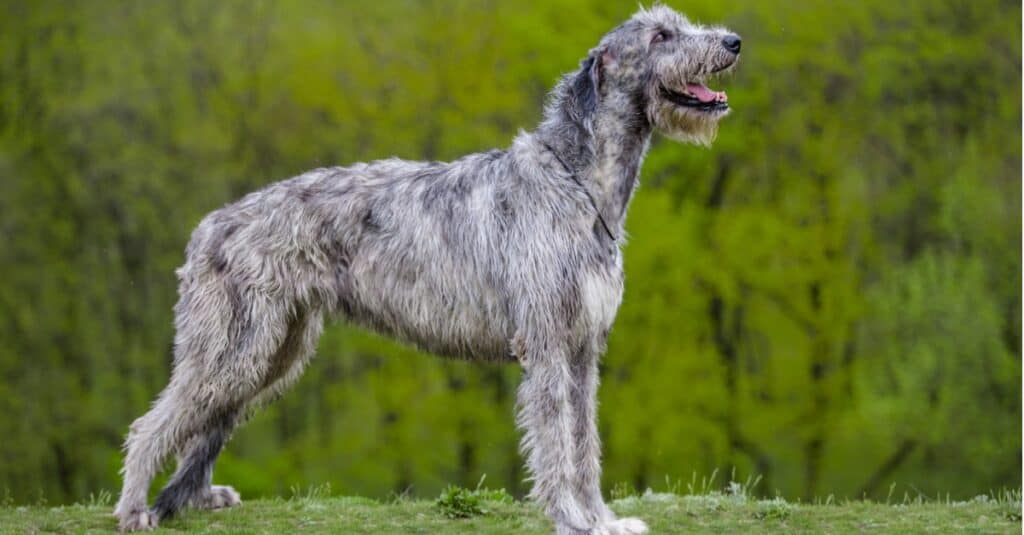
The average Irish wolfhound measures 32 inches or more at the shoulder.
©iStock.com/Ashva
The Irish wolfhound is the tallest American Kennel Club dog breed, with heights starting at 32 inches at the shoulder. That’s nearly 3 feet tall! They have similar builds as greyhounds but are larger and have longer fur. They were bred to hunt wolves, and with their size, they could overcome them, but they are calm, gentle pets that are loving with their owners. They have one of the shortest life expectancies, with the average falling between six to eight years. Some concerns with the Irish wolfhound include:
- Bone Cancer
- Heart Disease
- von Willebrand’s disease (a blood-clotting disorder)
- Bloat
- Lymphoma
- Hyperthyroidism.
1. French Mastiff (Dogue de Bordeaux), 5-8 Years

On average, French mastiffs weigh 110 pounds and are 23 inches tall.
©otsphoto/Shutterstock.com
The French mastiff has one of the shortest lifespans of all dog breeds in the world, with some living only five years, with others making it to the top of the range at eight years. The history of the French mastiff goes back so far we are unsure of their exact origins. Similar to bullmastiffs, they have a face like a bulldog but are shorter and stockier, weighing 110 pounds and averaging 23 inches tall. With proper training and socialization when they are young, they can become loyal pets (if you don’t mind pools of drool here and there!). They do have a variety of health concerns that lead to shorter lifespans, examples like the following:
- Breathing issues due to being brachycephalic (broad and short-skulled face)
- Heat issues
- Heart issues
- Breathing causes strain on other organs.
So if you have a big heart for a big dog, you just need to know what you are getting into. These dogs can provide years of companionship and love. Some dog owners who love these breeds know they have the opportunity to own several of these dogs over their own lifetime. While others enjoy having more than one of these breeds at the same time, can you imagine those dog food bills? With ongoing research, it is possible that the health issues that are common in these breeds may be solved, leading to an increased lifespan of some of these favorite dogs.
Summary of 10 Dogs With the Shortest Lifespans
Here is a list of 10 dogs with the shortest lifespans:
| Rank | Dog | Average Lifespan |
|---|---|---|
| 1 | French Mastiff (Dogue de Bordeaux) | 5-8 years |
| 2 | Irish Wolfhound | 6-8 years |
| 3 | Mastiff | 6-10 years |
| 4 | Bullmastiff | 7-9 years |
| 5 | Bernese Mountain Dog | 7-10 years (maybe 6-8) |
| 6 | Great Dane | 7-10 years |
| 7 | Saint Bernard | 8-10 years |
| 8 | Bulldog | 8-10 years |
| 9 | Newfoundland | 9-10 years |
| 10 | Rottweiler | 9-10 years |
The photo featured at the top of this post is © iStock.com/Jana Richter
Ready to discover the top 10 cutest dog breeds in the entire world?
How about the fastest dogs, the largest dogs and those that are -- quite frankly -- just the kindest dogs on the planet? Each day, AZ Animals sends out lists just like this to our thousands of email subscribers. And the best part? It's FREE. Join today by entering your email below.
Thank you for reading! Have some feedback for us? Contact the AZ Animals editorial team.






